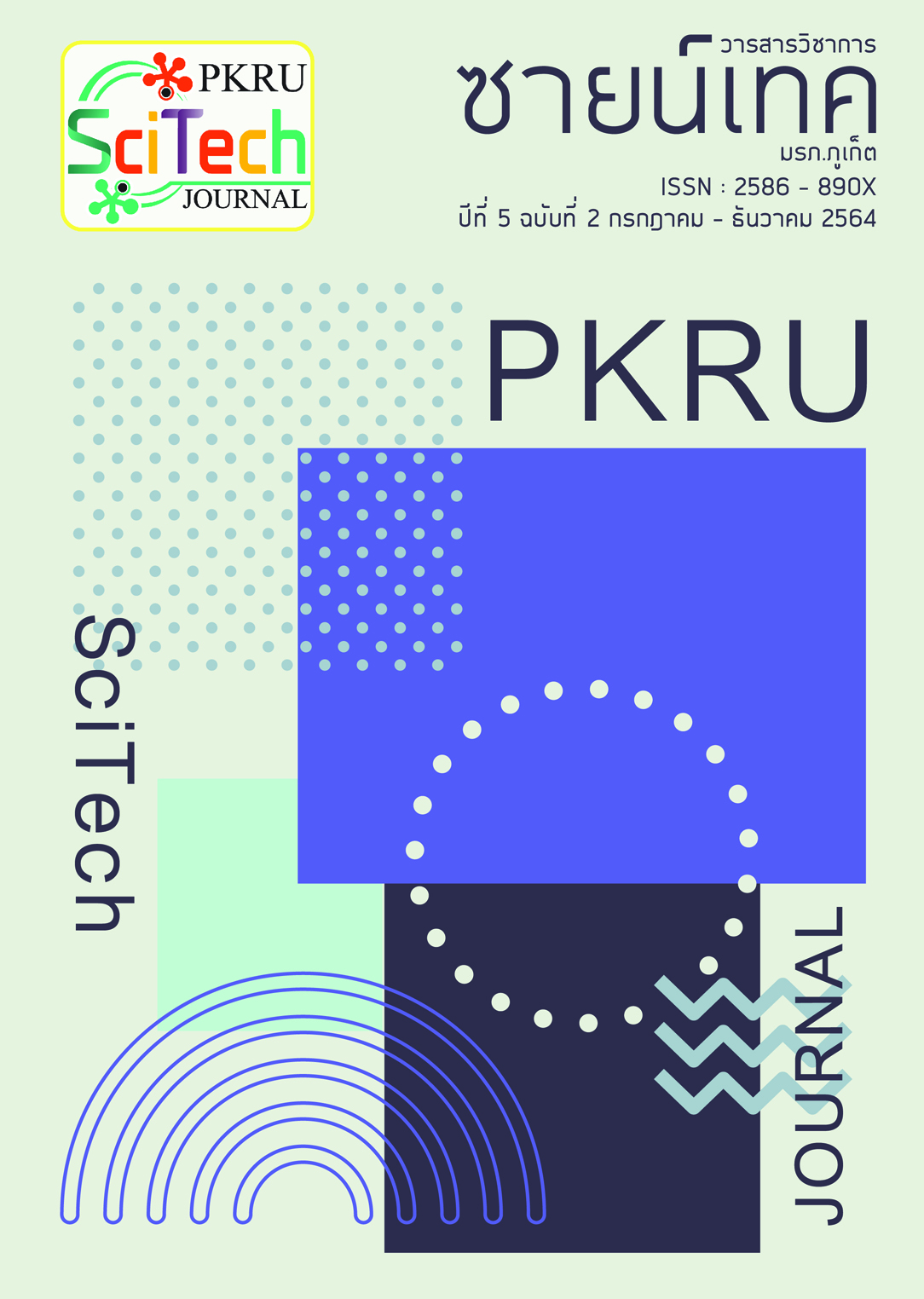Study of Type and Content of Pesticide Residue in Water of Agricultural Areas of Thonburi, Bangkok
Main Article Content
Abstract
Nowadays, there are pesticides that were focused because of concern of their residues in environments. Therefore, this research aims to assess contents of pesticide residues in water sources of agricultural areas then analyze related factors. The methods are determining contents of 55 types of insecticide from 4 groups including carbamate, organochlorine, organophosphate, and pyrethroid remaining in canals passing through agricultural areas in Bangkok, Thonburi in 4 districts composing Lampadong, Pathum, Seewa, and Namdang canal in Talingchan, Taweewattana, Nongkheam, and Bangbon districts, respectively. The research was done in 2 seasons of summer and rainy in April and June, respectively. Effect of the factors comprising of season, area, and type and group of pesticides was analyzed. The result showed that we found 7 types from 2 groups of pesticide residues including 3 types from carbamate group viz. Fenobucarb, Carbofuran, and Methomyl and 4 types from organophosphate group viz. Diazinon, Chlorpyrifos, Ethion, and Triazophos with mean of 0.038, 0.013, 0.074, 0.013, 0.013, 0.013, and 0.168 microgram/liter, respectively. However, effect from area, season, type and group of pesticides could not be found with p-value of 0.2610, 0.6440, 0.1150 and 0.1510, respectively. On the other hand, correlation of the contents in Nongkheam and Bangbon district was found with Pearson’s correlation coefficient (r) of 0.9959 and that of diazinon, chlorpyrifos, and ethion with r = 1.0000 at same significant level of 0.001.
Article Details
- The original content that appears in this journal is the responsibility of the author excluding any typographical errors.
- The copyright of manuscripts that published in PKRU SciTech Journal is owned by PKRU SciTech Journal.
References
Bassil, K. L., Vakil, C., Sanborn, M., Cole, D. C., & Kaur, J. S. (2007). Cancer health effects of pesticides. Canadian Family Physician, 53, 1704-1711.
ภาควิชาเภสัชวิทยา คณะสัตวแพทยศาสตร์ มหาวิทยาลัยเกษตรศาสตร์. (2559). สารกำจัดศัตรูพืช. กรุงเทพฯ: สำนักพิมพ์มหาวิทยาลัยเกษตรศาสตร์.
ไพฑูรย์ หมายมั่นสมสุข. (2553). การวิเคราะห์น้ำและน้ำเสียเบื้องต้น. กรุงเทพฯ: สำนักวิจัยและพัฒนาสิ่งแวดล้อมโรงงาน กรมโรงงานอุตสาหกรรม กระทรวงอุตสาหกรรม.
Rice, E. W., Baird, R. B., & Eaton, A. D. (2017). Standard methods for the examination of water and wastewater (23rd edition). Washington: American public health association, American water works association, Water environment federation.
Hamilton, D. J., Ambrus, A., Dieterle, R. M., Felsot, A. S., Harris, C. A., Holland, P. T., Katayama, A., Kurihara, N., Linders, J., Unsworth, J., & Wong, S. S. (2003). Regulatory limits for pesticide residues in water (IUPAC technical report). International Union of Pure and Applied Chemistry, 75(8), 1123-1155.
พัชรี ภคกษมา, สุวรรณี สายสิน, และศรมน สุทิน. (2559). การตรวจสอบสารเคมีฆ่าแมลงตกค้างของสารกลุ่มออร์แกโนฟอสเฟตและคาร์บาเมต. วารสารวิชาการสมาคมสถาบันอุดมศึกษาเอกชนแห่งประเทศไทย ในพระบรมราชูปถัมภ์ สมเด็จพระเทพรัตนราชสุดาฯ สยามบรมราชกุมารี, 5 (1), 22-30.
อรอุมา สร้อยจิต, และสุวิทย์ คล่องทะเล. (2562). การตรวจหาสารเคมีกำจัดแมลงกลุ่มออร์แกโนฟอสเฟตและคาร์บาเมตที่ตกค้างมากับผักที่ใช้ประกอบอาหารในร้านอาหารของชุมชนใกล้มหาวิทยาลัยรังสิต ต.หลักหก อ.เมืองปทุมธานี จ.ปทุมธานี (หน้า 138-149). ใน การประชุมวิชาการระดับชาติ มหาวิทยาลัยรังสิต ประจำปี 2562. ปทุมธานี.
Tam, N. T., Berg, H., & Cong, N. V. (2018). Evaluation of the joint toxicity of chlorpyrifos ethyl and fenobucarb on climbing perch (Anabas testudineus) from rice fields in the Mekong Delta, Vietnam. Environmental Science and Pollution Research, 25, 13226-13234.
Kim, I., Kim, D. U., Kim, N. H., & Ka, J. O. (2014). Isolation and characterization of fenobucarb-degrading bacteria from rice paddy soils. Biodegradation, 25, 383-394.
Plangklang, P., Reungsang, A., & Suphannafai, W. (2011). Bioremediation of carbofuran contaminated soil under saturated condition: soil column study. Biodegradation, 23, 473-485.
Begum, G. (2008). Assessment of biochemical markers of carbofuran toxicity and recovery response in tissues of the freshwater teleost, Clarias Batrachus (Linn). Bulletin of Environmental Contamination and Toxicology, 81, 480-484.
Derbalah, A., Chidya, R., Jadoon, W., & Sakugawa, H. (2019). Temporal trends in organophosphorus pesticides use and concentrations in river water in Japan, and risk assessment. Journal of Environmental Science, 79, 135-152.
Sosan, M. B., Akingbohungbe, A. E., Ojo, I. A. O., & Durosinmi, M. A. (2008). Insecticide residues in the blood serum and domestic water source of cacao farmers in Southwestern Nigeria. Chemosphere, 72(5), 781-784.
Kulshrestha, G., & Kumari, A. (2011). Fungal degradation of chlorpyrifos by Acremonium sp. strain (GFRC-1) isolated from a laboratory-enriched red agricultural soil. Biology and Fertility of Soils, 47, 219-225.
Heidar, H., Omid, N. S. T., & Abbasali, Z. (2017). Monitoring organophosphorus pesticides residues in the Shahid Rajaee Dam reservoir, Sari, Iran. Bulletin of Environmental Contamination and Toxicology, 98, 791-797.
Mahboob, S., Niazi, F., Alghanim, K., Sultana, S., Misned, F. A., & Ahmed, Z. (2015). Health risks associated with pesticide residues in water, sediments and the muscle tissues of Catla catla at Head Balloki on the River Ravi. Environmental Monitoring and Assessment. 187, 463-470.
Glinski, D. A., Purucker, S. T., Meter, R. J. V., Black, M. C., & Henderson, W. M. (2018). Analysis of pesticides in surface water, stemflow, throughfall in an agricultural area in South Georgia, USA. Chemosphere, 209, 496-507.


